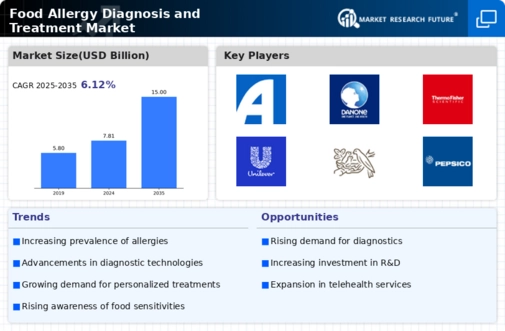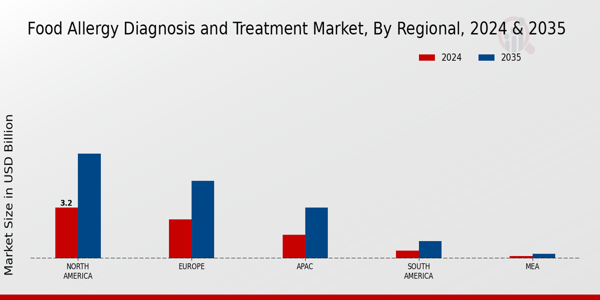Food Allergy Diagnosis Treatment Size
Food Allergy Diagnosis Treatment Market Growth Projections and Opportunities
The Food Allergy Diagnosis Treatment Market is influenced by several key market factors that shape its dynamics and growth trajectory. Firstly, the rising prevalence of food allergies worldwide is a significant driver of market expansion. Over the past few decades, there has been a notable increase in the incidence of food allergies across various age groups and demographics, leading to a greater demand for diagnostic tools and treatments.
Additionally, increased awareness and improved diagnostic techniques contribute to market growth. As awareness about food allergies grows among healthcare professionals and the general population, more individuals are seeking diagnosis and treatment options. Advances in diagnostic technologies, such as blood tests and skin prick tests, have enhanced the accuracy and accessibility of food allergy diagnosis, further fueling market demand.
Moreover, regulatory initiatives and government policies play a crucial role in shaping the food allergy diagnosis treatment market. Regulatory agencies around the world are actively involved in setting standards for the approval and commercialization of allergy diagnostic tests and treatments. Compliance with regulatory requirements is essential for market players to ensure the safety and efficacy of their products and to gain market approval.
Furthermore, the increasing investments in research and development activities drive innovation in food allergy diagnosis and treatment. Pharmaceutical companies, diagnostic laboratories, and academic institutions are investing significant resources in developing new diagnostic tools, therapeutic agents, and immunotherapy approaches for managing food allergies. These investments not only expand the product pipeline but also contribute to the overall growth and evolution of the market.
Additionally, changing dietary habits and lifestyle patterns influence the prevalence and management of food allergies, thereby impacting market dynamics. As people adopt diverse diets and consume a wider range of food products, the risk of encountering allergens increases, driving the demand for effective diagnostic and treatment solutions. Furthermore, lifestyle factors such as urbanization and globalization contribute to the spread of food allergies, creating new opportunities for market players to address emerging needs.
Moreover, the economic landscape and healthcare infrastructure of different regions shape the accessibility and affordability of food allergy diagnosis and treatment options. Disparities in healthcare access and reimbursement policies influence the adoption of allergy testing and treatment modalities, particularly in developing countries. Market players need to consider these factors while developing strategies to penetrate new markets and expand their global footprint.
















Leave a Comment